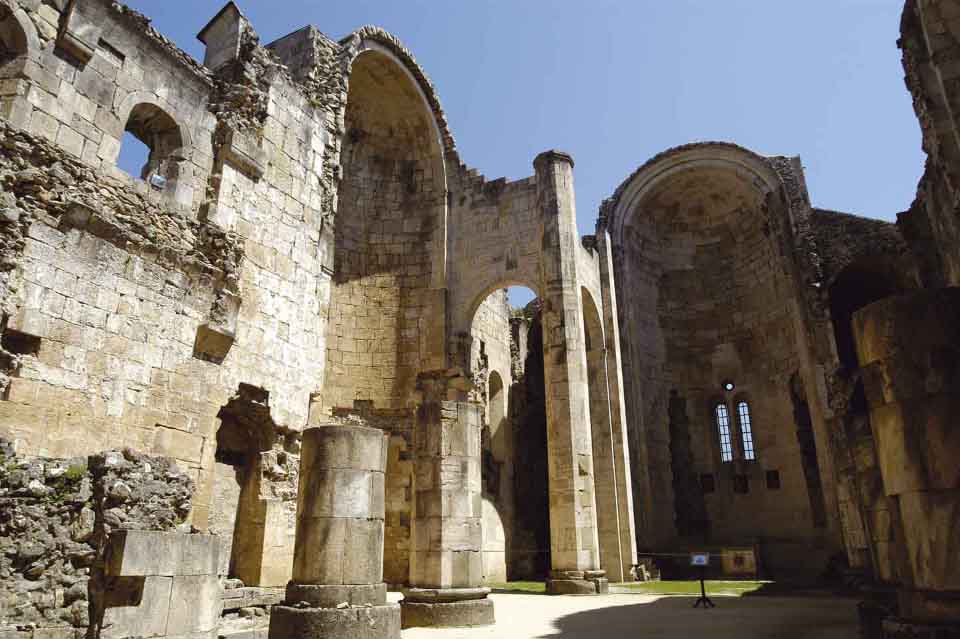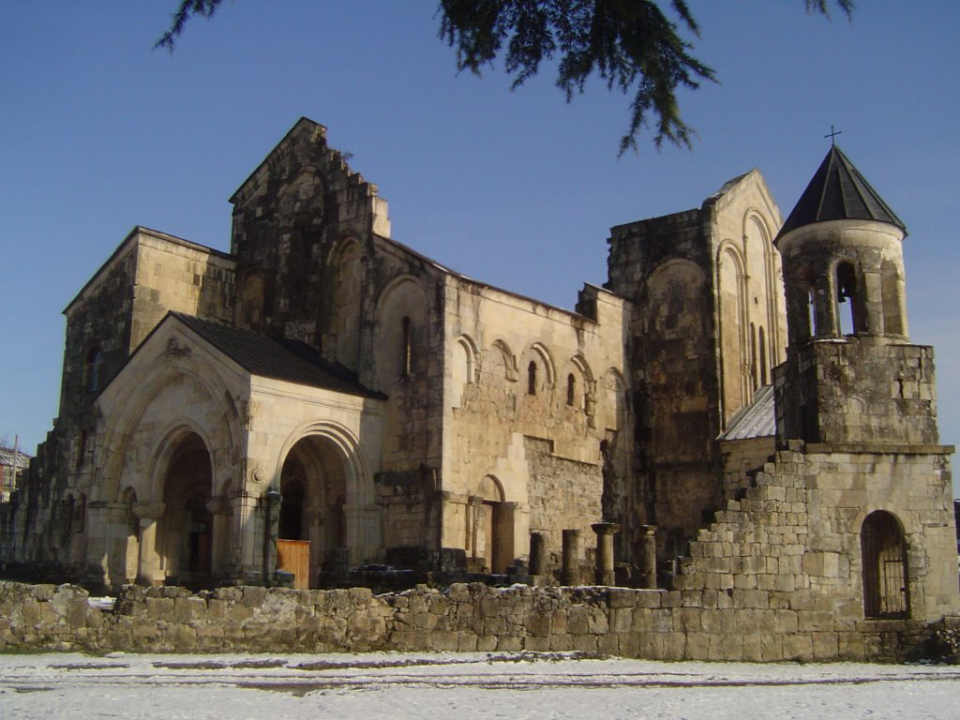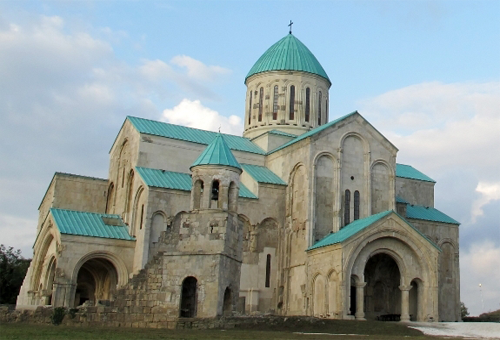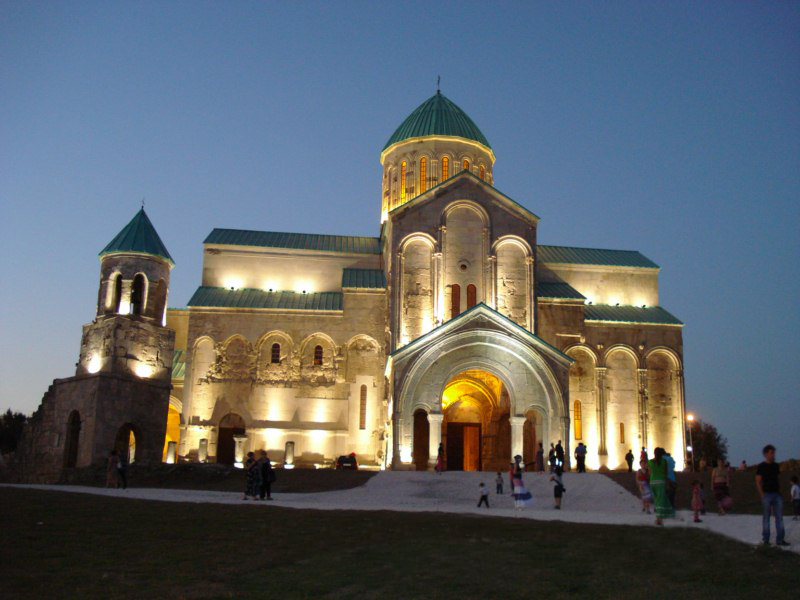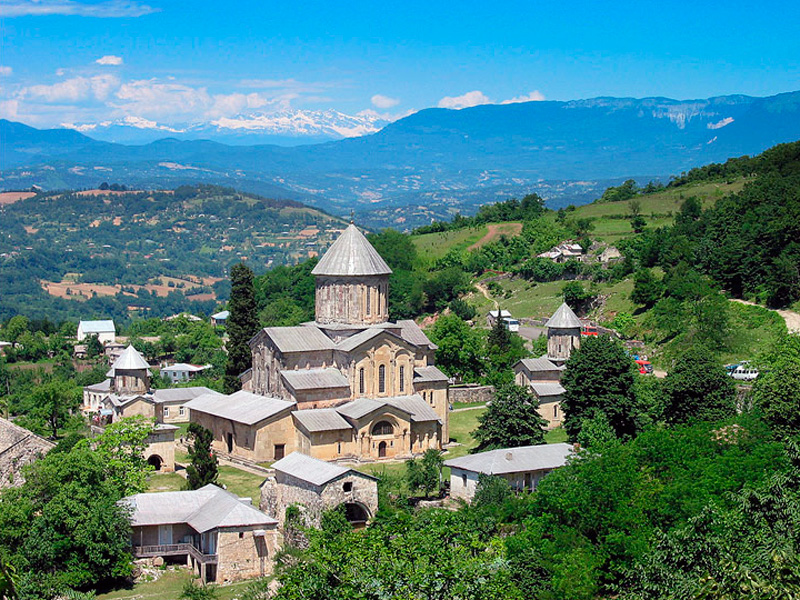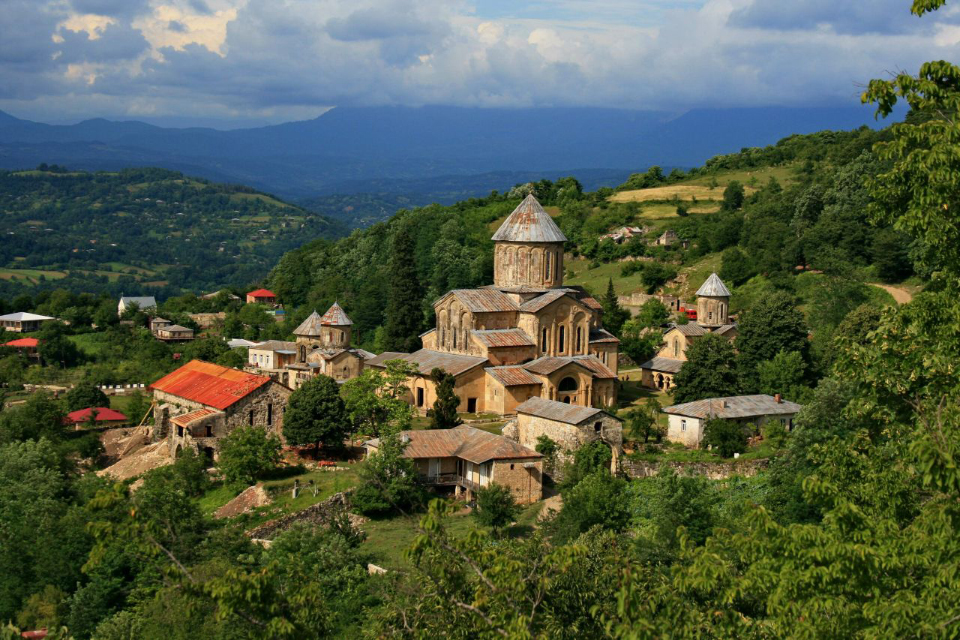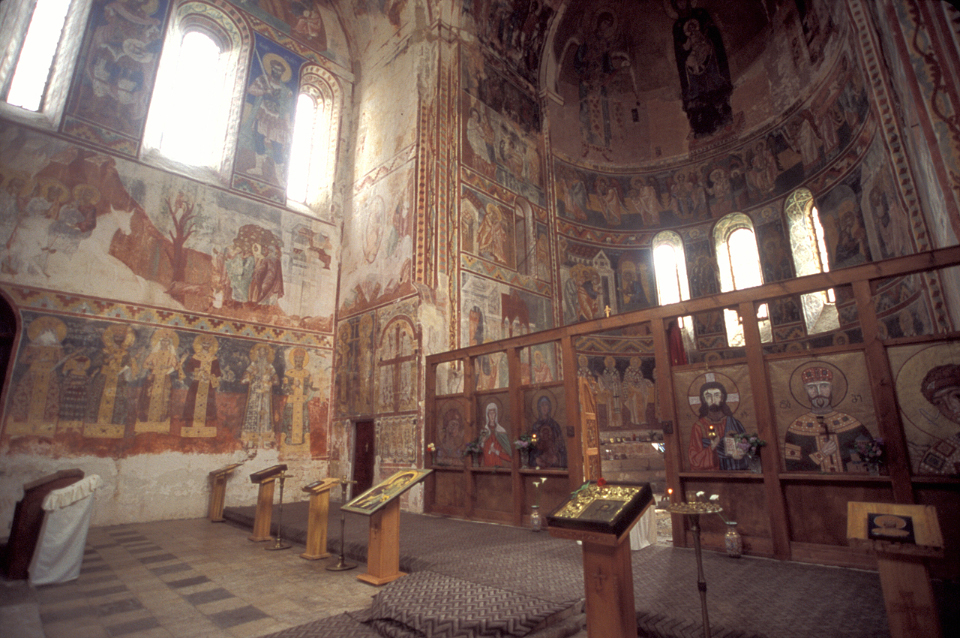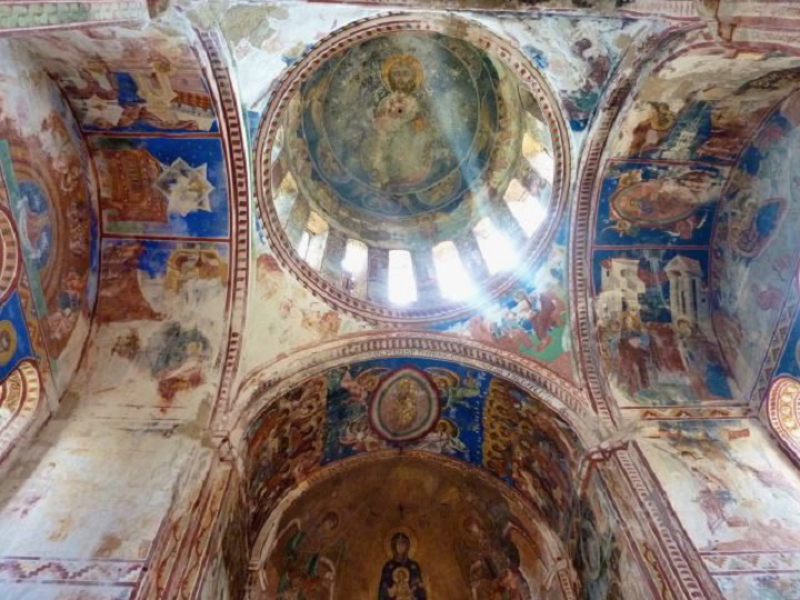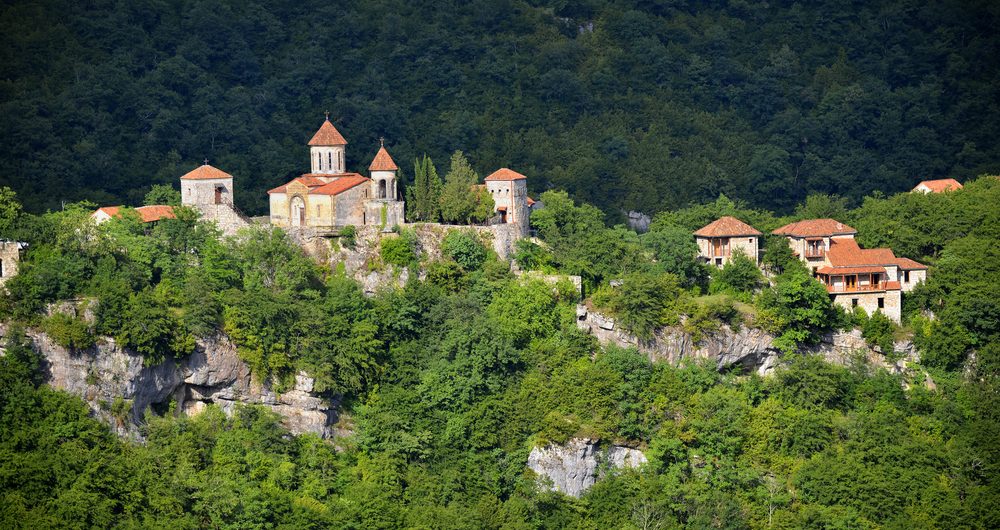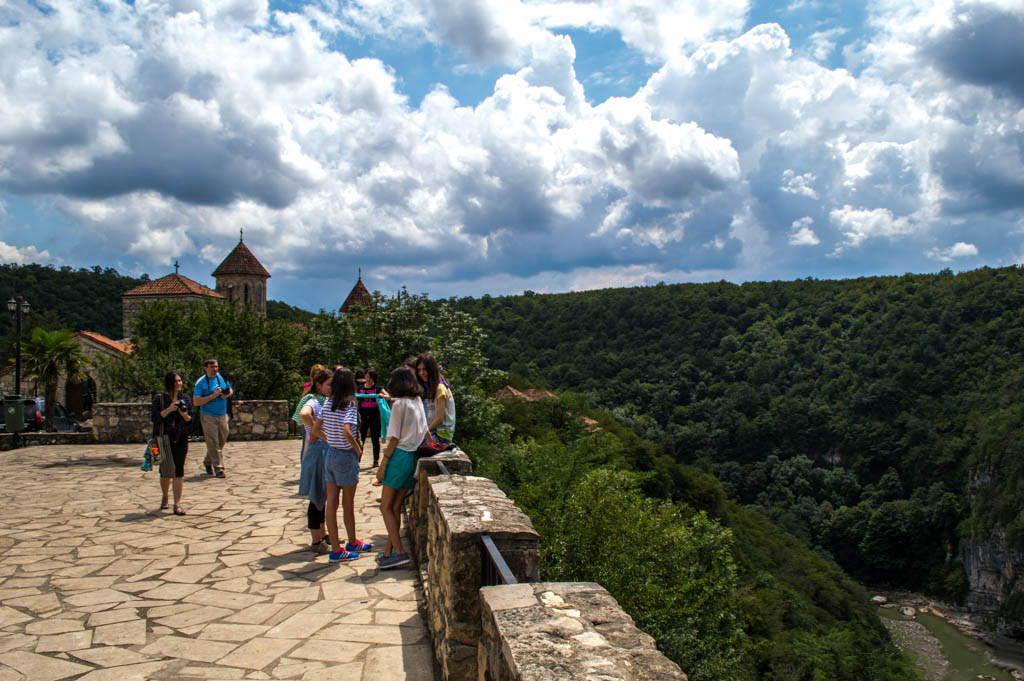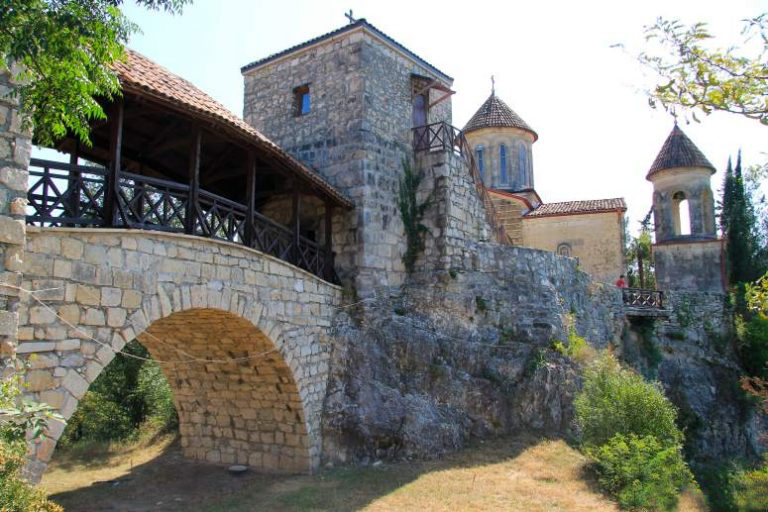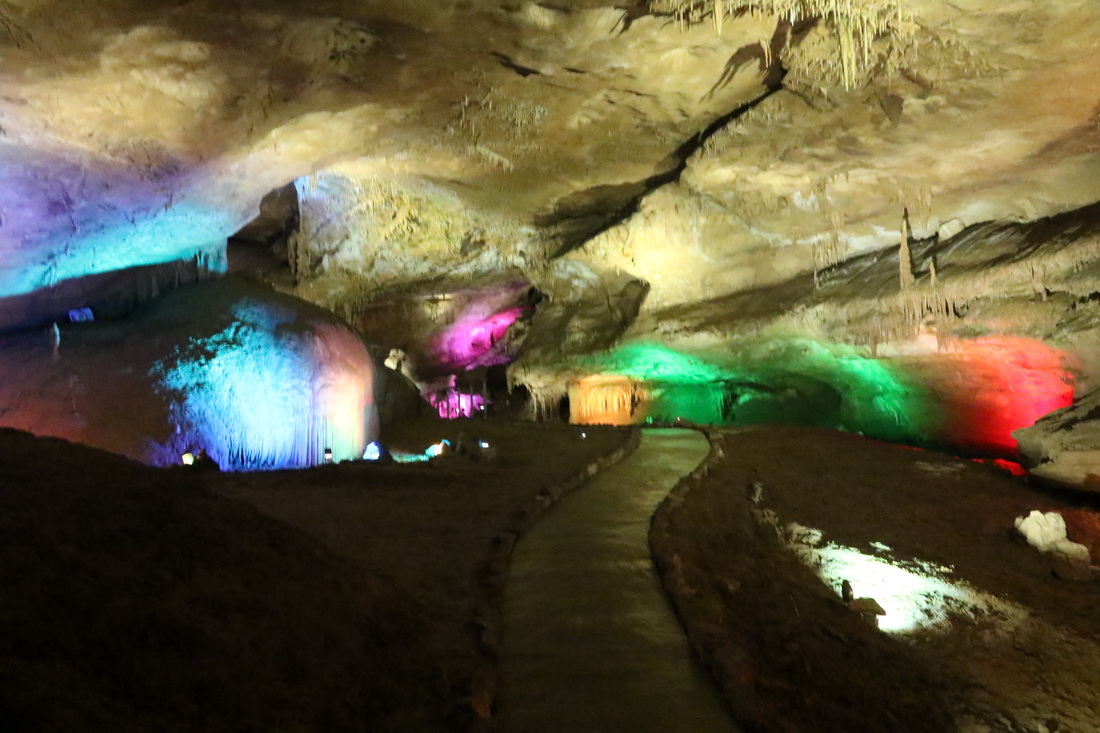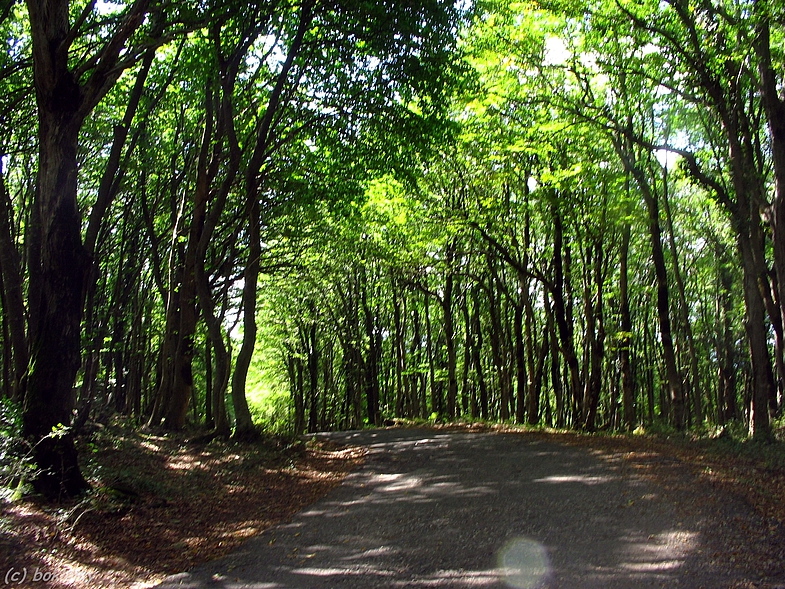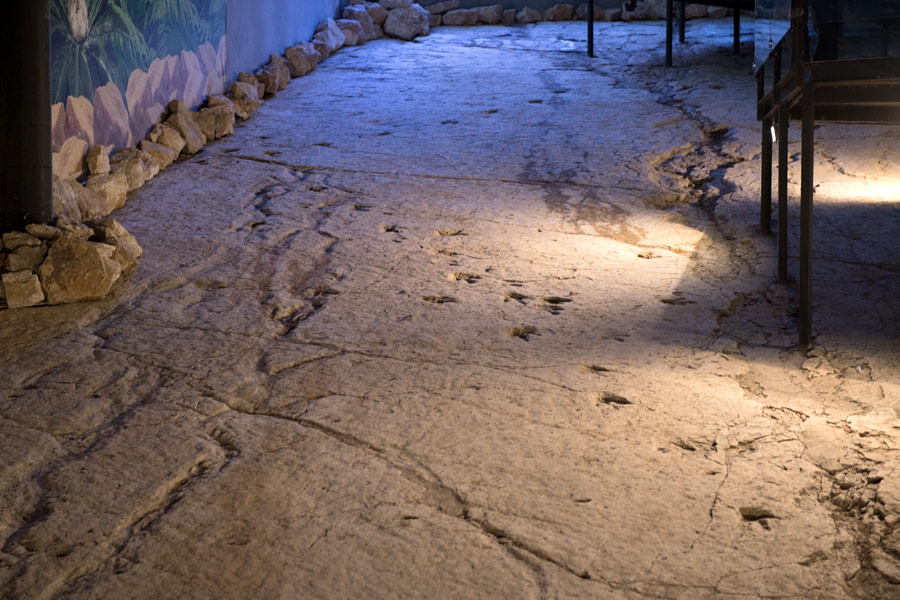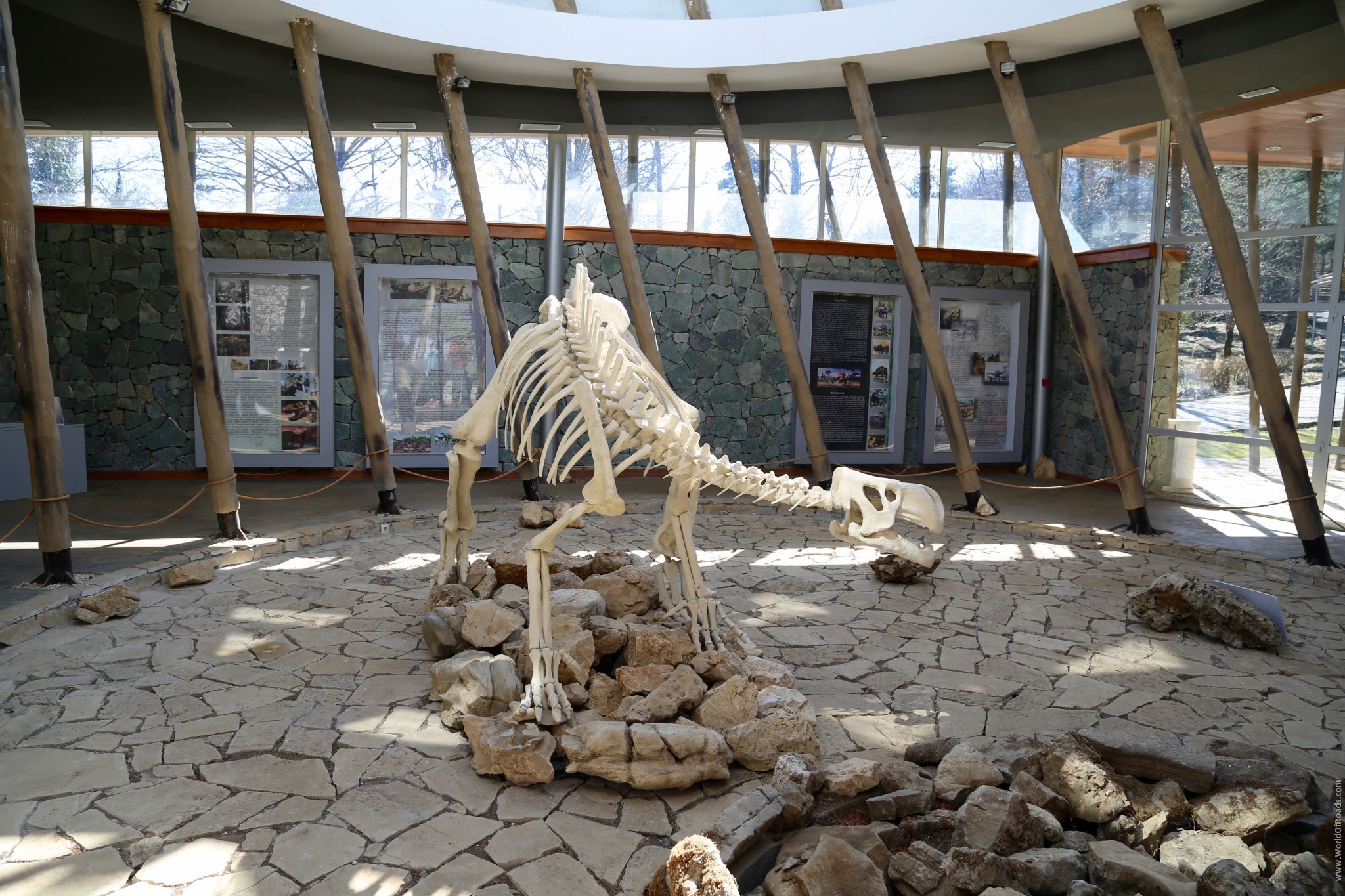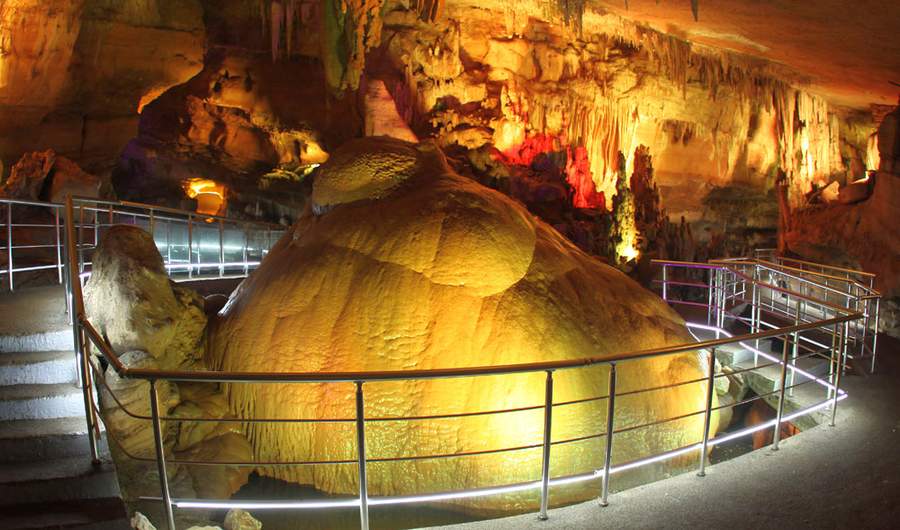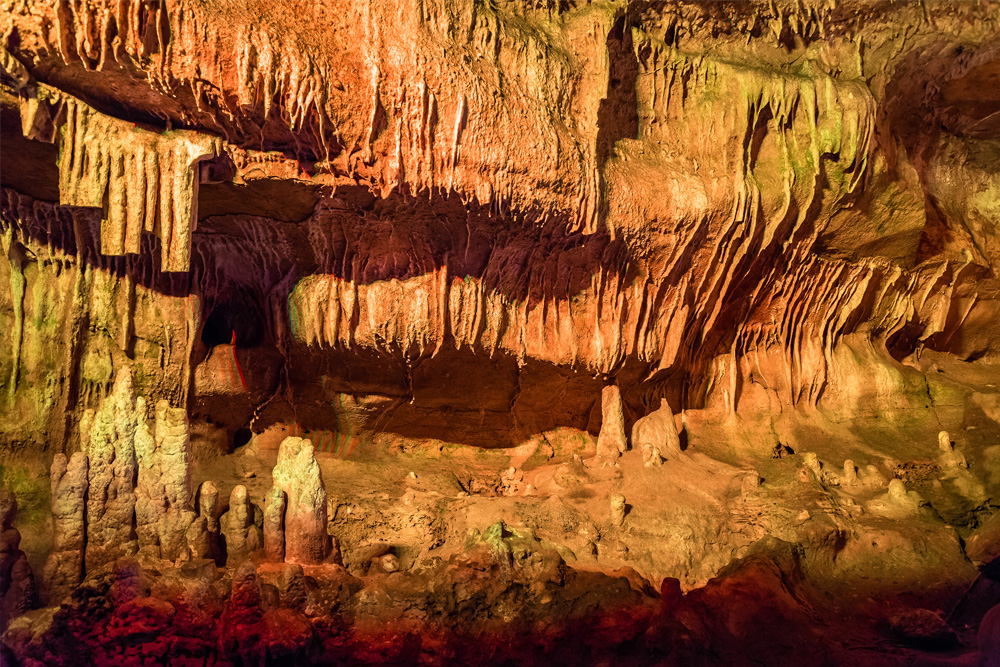

Cathedral of King Bagrat, built by King Bagrat III in Kutaisi, the masterpiece of ancient Georgian architecture. It was founded when a united Feudal
Government of Georgia was established out of the separate kingdoms/principalities (on the edge of X-XI centuries).
The United Georgia required the temples suitable for the epoch. Many wonderful monuments of Georgian architecture were established during this
period and have been maintained till present, and this includes the cathedral built by Bagrat III, which was of special importance. Though the cathedral is
found today in ruins, even these ruins speak of the high-level skills and talent of the master who built this temple.
Cathedral of King Bagrat is located on the height of the right bank of the Rioni River within the walls of the ancient town. A stone fence surrounds the
cathedral, and from the east it borders the ruins of the Citadel of Old Kutaisi.
The construction of the cathedral was finished in 1003. According to the chronicler the cathedral was built and consecrated during the reign of Bagrat
III (975-1014), but he was not able to finish the decorative works to the cathedral that chronologically was finally completed during the reign of Bagrat IV
(1027-1072). The architectural analysis of the cathedral also proves the correctness of the information in written historical sources. The cathedral was built
to bear the name of St. Virgin but because of the great desert of Bagrat III, the first king of the United Georgia and the builder of the cathedral it is called
“Cathedral of King Bagrat”.
The architect of the cathedral paid special attention to decorations. The facades of the temple contain the decorated arches and pilasters.
To Bagrat III’s mind building the cathedral in the then capital city of Kutaisi was of great importance that should become the symbol of a United
Georgia. Bagrat III made sanctifying the cathedral as a noble holiday. The chronicler writes that Bagrat III invited the rulers of near and far governments,
the temporal and ecclesiastic leaders.
Cathedral of King Bagrat stood firmly during seven centuries and fascinated many visitors with its grandiosity and wonderful decorations. However, the
cathedral was ruined in 1691 during the struggle against Turks. It was damaged more during the reign of the Turks - between the 60s of the XVII century
and 1770.
The cathedral plan with stretched-out arms creates the form of a cross with a dome above in the center built on four pillars. To this, the arm of the
cathedral in the west part is lengthened.
The cathedral has one entrance from the west side. The gate built in the façade was reconstructed in 1984-90.
The western gate is used as the main entrance of the cathedral. The whole western façade of the temple is decorated with ornamented long frames of
windows and beautiful pilasters. The cathedral can be entered from the western gate, which had two-storied sections from the southern and northern sides.
The second floor used to be an open-window chamber. In the waiting section of the cathedral there are fundaments of four big pillars. On them there used
to be the marble pillars finishing with nicely ornamented capitals. The main ornaments for capitals represented the figures of geometrical forms, plants and
animals.
On the eastern side of the central part of the cathedral according to the remained parts it is possible to restore the three sections of the apse. According
to the historical sources there were mural paintings on the walls inside the cathedral. In the southern side of the cathedral there was built the wonderfully
ornamented gate with wide star-form arched entrance that was kept in the best shape. The eastern façade with its beauty and ornaments is worth of paying
attention. Its two triangular niches create a clear imagination on its original ornamentation. The row of pilasters coming down on the outer side of the
northern façade of the cathedral attracts the visitors’ attention. In the east of the northern gate, on the second floor, there is an inscription on one side of
the window in which is mentioned the king of Georgia Bagrat III. On the other side of the window there is an inscription indicating the year of building the
cathedral (1003) that is very interesting also in respect that it is one of the oldest samples of using the Arabic numerals.
Cathedral of King Bagrat was ruined during the struggle against Turks in the XVII century. Later in the XIX century the western gate and other parts
were ruined “but the monument creates an amazing impression with its neat proportions, the refined combination of the parts and the highest artistic level
of the performance. Here all the parts are harmoniously combined with each other. The distinguished diversity and lively form was given to the building
with its stretched-out arms, gates, and the tower-form built-in part on the western side. The cathedral ornament is carved lightly and neatly, and spread on
the walls and the gates like a spider-net.”
With its historical and artistic importance Cathedral of King Bagrat takes special place among the monuments of the medieval art. This is the brightest
sample of the architectural genii created in the XI century. Though the cathedral was damaged greatly by the enemies but the remained walls and the
separate parts of the temple prove the greatest talent of the master and his unlimited fantasy.
The scientific definition of architectural importance of Cathedral of King Bagrat is connected with the name of Academician George Chubinashvili, the
founder of Georgian Art Critic School, who in 1925 gave Cathedral of King Bagrat a deserved place along with Svetitskhoveli and Alaverdi Cathedrals in
the Georgian Art History.
The reconstructing works of Cathedral of King Bagrat started in 1940, when a group of researchers under the leadership of G. Chubinashvili and N.
Severov began studying and cleaning works of the cathedral and its surroundings. Upon the initiative of G. Chubinashvili this task was given to the art
critic Vakhtang Tsintsadze who spent half a century on completing such a substantial work. Thanks to those reconstruction projects, the present-day
visitors are able to get acquainted with their heritage. It is worth even if we talk of restoration of the western side gate and the columns erected up to the
dome inside the cathedral.
When we refer to the historical and artistic importance of this monument we should not leave without attention the event related to the Cathedral of
King Bagrat - at the gate of this temple was arranged crowning of David Aghmashenebeli in 1089.
It was like a prediction for David Aghmashenebeli the prayer of the Catholicos of Georgia served in the cathedral: “David became the devoted king of
the nation, the bearer of Georgia’s integrity and powerfulness. That’s why Cathedral of King Bagrat became adoring and attractive place for All Georgia".
On December 17, 1994 the UNESCO registered Cathedral of King Bagrat along with Gelati and Svetitskhoveli Cathedrals as the significant monument
among the world’s other cultural sites.
On May 7, 1994 Archbishop and the World Patriarch of Constantinople and the New Rome visited Kutaisi along with Saint of Saints Bartholomew I,
Catholocos-Patriarch of All Georgia, and Archbishop of Mtskheta-Tbilisi, His Holiness Ilia II with the accompanied persons, and consecrated the Sioni
Church.
In the same year was established the Fund of Revival of King Bagrat's Cathedral and its adjoining complex.
On August 27, 1995, on the Day of the Virgin Mother for the first time during last 303 years in the big cathedral in the open air the Kutatian-Gaenatian
Metropolitan Kalistrate along with the Eparchy clergy conducted the first service.
On April 30, 1996 His Holiness Alex II, Patriarch of Moscow and All Russia, along with the accompanying persons and Catholocos-Patriarch of All
Georgia Ilia II along with Georgian clergy conducted the ceremony of consecration in the cathedral.
In 2003 was arranged the thousand year anniversary of King Bagrat's Cathedral.

Motsameta, historical village in Tkibuli Region, to the west of Okriba, on the right bank of the Tskaltsitela River. From the west, it is bordered by Kutaisi, from the south - by the village Godogani (Terjola Region), and from the northeast - by the village Gelati. The village is situated at 380m above sea level. The railway and the highway, connecting Tkibuli and Kutaisi pass through the village. The village was first mentioned in the historical sources that date back to the VII c.
The most important site in Motsameta is the Monastery Complex - a brilliant sample of ancient Georgian architecture.
Motsameta Monastery Complex is an important Georgian architectural monument dated back to the XI century. It is located on an open spot with a forest covered mountain. The Tskaltsitela River flows along three sides of the monastery. The Tskaltsitela River valley, where together with the monastery are located castles and towers, represented one of the most developed areas of the region. A VIII century chronicle mentions this place in his records under name “Tskaltsiteli” and describes it as “a city-fort with many residents”. From a strategic point of view, “Tskaltsiteli” is conveniently located. It is a peninsula created by the river, which is protected with cliff from each side, which made it an important military-strategic point in the Medieval Ages.
In the 30s of the VIII century, the ruler Murvan-the-Deaf raided Georgia. Consequently, the destruction that the relentless raiding brought is apparent as the castle “Tskaltsiteli” is in ruins. David and Konstantine Mkheidzes, the rulers of Argveti area constantly terrified and harassed the enemy with their unexpected counter attacks. Finally, under commander Murvan’s order, the Arabs managed to catch the rulers alive. They were tortured and then bound their hands and legs, and tied them to large rocks and threw them in the river. The Kutatian people found the bodies of their dead heroes along the riverbank, and buried them in the crypt of the former Khareba (Annunciation) Church. Murvan-the-Deaf later destroyed the church. Time passed but people never forgot the heroic deeds of the Mkheidzes. Georgian Apostolic Church considers them as saints and created a special holiday for mentioning the names of the martyrs called “Motsametoba” or “Ortsipoba” (by old calendar - October 2, by new calendar - October 15), the day when David and Konstantine Mkheidzes were tortured and killed (“tsameba” in Georgian means “torturing”).
However, after “Tskaltsiteli” was raided by Murvan-the-Deaf it never lost its importance, and during the middle of the VIII century “Tskaltsiteli” became the main site of cult worship. It is believed that the Motsameta Monastery was built in the XI century by King Bagrat IV. This idea is based on the leader’s cross of the Motsameta Church that is preserved in the Kutaisi State Museum of History and Ethnography.
In the yard of the Motsameta Church some remains dated back to the early Medieval Ages are preserved, among which the most important is the Bolnian type cross-medallion, and a square-stone with a diameter of 30cm that was accidentally revealed during the reconstruction of the old gate. Such crosses were characteristic of many religious areas throughout Georgia. The Motsameta cross is included in the group of crosses that date back to the second half of the V century and are known under the name “Bolnian crosses”.
The church is no longer in its original form. It may be considered that the interior was of minor size. It did not have any dome. During the XIX century, reconstruction works were carried out. Between 1844 and 1865, the Motsameta Khareba Church was completely rebuilt. A stone floor was created and two new windows of equal size were made to allow additional light into the church. The Motsameta Church is a cross-shape domed building. All four wings of the church are of equal size. The dome is based on four columns. The church has two entrances - western and southern doors. The church has an altar in the north, which is an exception among Georgian Christian architectural monuments. It is believed that this may be because of the fact that in the most respected place of the church - in the east were buried the saint martyrs David and Konstantine. The altar is divided with a wooden iconostasis made in the XIX century, which depict scenes from the gospels and the lives of saints. On the left side of the altar, on a raised place on two ornamented wooden lions there a special wooden box rests, in which were placed the remains of the saints. There is a small amount of open space under the box, where the believers may pass on their knees. During the anti-religious campaign, on April 20, 1923, the liturgy was abolished at the Motsameta Monastery. On June 20 of the same year the remains of the saints and some part of the church property were moved to the Kutaisi Museum. The church began functioning again in 1954, which is indicated by an inscription on the wall of the church’s western waiting hall. In this inscription is mentioned Kutatian-Gaenatian Metropolitan Gabriel, Kutatian-Gaenatian bishop Naom (Shavianidze), priest Sulakadze, with whose great efforts the liturgy was reestablished in this church. It was just this time, when David and Konstantine’s remains were moved from the Kutaisi Museum and returned to the Motsameta Church. In the south of the church there is a two-floor belfry, on which is preserved an inscription informing that the church was built in 1845 under the order of the Metropolitan of Imereti, David. Nearby the living chambers of the people serving in church are located. To the west of the church there is a long waiting space, which was built on the ground of the old church. Over the waiting place, in 1960, they built the residence of the church leader. The people who served at this church during XIX and XX century are buried in the churchyard.
The most important site in Motsameta is the Monastery Complex - a brilliant sample of ancient Georgian architecture.
Motsameta Monastery Complex is an important Georgian architectural monument dated back to the XI century. It is located on an open spot with a forest covered mountain. The Tskaltsitela River flows along three sides of the monastery. The Tskaltsitela River valley, where together with the monastery are located castles and towers, represented one of the most developed areas of the region. A VIII century chronicle mentions this place in his records under name “Tskaltsiteli” and describes it as “a city-fort with many residents”. From a strategic point of view, “Tskaltsiteli” is conveniently located. It is a peninsula created by the river, which is protected with cliff from each side, which made it an important military-strategic point in the Medieval Ages.
In the 30s of the VIII century, the ruler Murvan-the-Deaf raided Georgia. Consequently, the destruction that the relentless raiding brought is apparent as the castle “Tskaltsiteli” is in ruins. David and Konstantine Mkheidzes, the rulers of Argveti area constantly terrified and harassed the enemy with their unexpected counter attacks. Finally, under commander Murvan’s order, the Arabs managed to catch the rulers alive. They were tortured and then bound their hands and legs, and tied them to large rocks and threw them in the river. The Kutatian people found the bodies of their dead heroes along the riverbank, and buried them in the crypt of the former Khareba (Annunciation) Church. Murvan-the-Deaf later destroyed the church. Time passed but people never forgot the heroic deeds of the Mkheidzes. Georgian Apostolic Church considers them as saints and created a special holiday for mentioning the names of the martyrs called “Motsametoba” or “Ortsipoba” (by old calendar - October 2, by new calendar - October 15), the day when David and Konstantine Mkheidzes were tortured and killed (“tsameba” in Georgian means “torturing”).
However, after “Tskaltsiteli” was raided by Murvan-the-Deaf it never lost its importance, and during the middle of the VIII century “Tskaltsiteli” became the main site of cult worship. It is believed that the Motsameta Monastery was built in the XI century by King Bagrat IV. This idea is based on the leader’s cross of the Motsameta Church that is preserved in the Kutaisi State Museum of History and Ethnography.
In the yard of the Motsameta Church some remains dated back to the early Medieval Ages are preserved, among which the most important is the Bolnian type cross-medallion, and a square-stone with a diameter of 30cm that was accidentally revealed during the reconstruction of the old gate. Such crosses were characteristic of many religious areas throughout Georgia. The Motsameta cross is included in the group of crosses that date back to the second half of the V century and are known under the name “Bolnian crosses”.
The church is no longer in its original form. It may be considered that the interior was of minor size. It did not have any dome. During the XIX century, reconstruction works were carried out. Between 1844 and 1865, the Motsameta Khareba Church was completely rebuilt. A stone floor was created and two new windows of equal size were made to allow additional light into the church. The Motsameta Church is a cross-shape domed building. All four wings of the church are of equal size. The dome is based on four columns. The church has two entrances - western and southern doors. The church has an altar in the north, which is an exception among Georgian Christian architectural monuments. It is believed that this may be because of the fact that in the most respected place of the church - in the east were buried the saint martyrs David and Konstantine. The altar is divided with a wooden iconostasis made in the XIX century, which depict scenes from the gospels and the lives of saints. On the left side of the altar, on a raised place on two ornamented wooden lions there a special wooden box rests, in which were placed the remains of the saints. There is a small amount of open space under the box, where the believers may pass on their knees. During the anti-religious campaign, on April 20, 1923, the liturgy was abolished at the Motsameta Monastery. On June 20 of the same year the remains of the saints and some part of the church property were moved to the Kutaisi Museum. The church began functioning again in 1954, which is indicated by an inscription on the wall of the church’s western waiting hall. In this inscription is mentioned Kutatian-Gaenatian Metropolitan Gabriel, Kutatian-Gaenatian bishop Naom (Shavianidze), priest Sulakadze, with whose great efforts the liturgy was reestablished in this church. It was just this time, when David and Konstantine’s remains were moved from the Kutaisi Museum and returned to the Motsameta Church. In the south of the church there is a two-floor belfry, on which is preserved an inscription informing that the church was built in 1845 under the order of the Metropolitan of Imereti, David. Nearby the living chambers of the people serving in church are located. To the west of the church there is a long waiting space, which was built on the ground of the old church. Over the waiting place, in 1960, they built the residence of the church leader. The people who served at this church during XIX and XX century are buried in the churchyard.

The Prometheus Cave is located near the resort town of Tskhaltubo, about 20 km from Kutaisi, in Imereti region of western Georgia.
The Prometheus Cave is actually a gift of nature, with an underground river, a lake and even an underground waterfall. It was primarily discovered in 1984, but in 2010, in cooperation with German scientists and builders, it was well-equipped and became a real natural wander and a popular tourist destination.
Slowly going down the steps, you feel how your mood is changing as if you are visiting Alibaba. Quiet pleasant music accompanies you while walking there.
Only one-tenth of it is open for tourists, and the walk through the cave takes almost an hour. Inside there are underground lakes and rivers. Humidity there is also very high. Today, the Prometheus Cave, surrounded by a specially designed natural area with a radius of 3 kilometers, is one of the most tempting places for Georgian guests. A visit to the cave gives a chance to see the underground world of this region in all its glory. Tourists can choose a 1600 meter walking route through the grottoes of the cave and / or a boat trip on a real underground river. The route passes by breathtaking stalactites and stalagmites, underground waterfalls, rivers and even the whole lake. A sense of mystery is added to this by a system of multicolored underground lighting, based on liquid crystal lamps, and constantly playing classical music in the cave, which makes the route even more attractive and memorable.
Large halls with stalactites and stalagmites of the most unusual shapes and colors - snow-white, sparkling blue, red - seem even more graceful in the ensemble with the background classical music and special lighting. For those who love such fabulous places, you can look at individual figures and imagine various fairy-tale characters looking at you.
Almost every cave has its own folk stories, so does this cave. It was given the name - Prometheus cave since near the cave is Mount Khvamli -one of the most magical places in Georgia. Mysterious history of Khvamli Mountain attracts and bewitches more and more tourists. According to the legends, here Prometheus was chained to the mountain, where somewhere in these places, the Georgian queen Tamar kept her own treasures. According to the old ancient Georgian national epic, it was in these places that Amirani was chained.
Amirani is a Georgian prototype of Promrthrus, he was the man who stole fire from the gods and gave it to the people.
Amirani was born by a goddess of hunting Dali, but his father was a mere mortal man. According to one legend, Amirani's father was a hunter, to the other - a blacksmith, and to the third - a simple peasant. Amirani was born prematurely and, fearing for his life, his mother sent him to ripen in the stomach of the bull. When the grown Amirani left his abode, he was marked with a symbol of divine origin - on his shoulders the moon and the sun were depicted. In addition, the young man was extremely strong and brave, and his inseparable companion was his sword, forged by himself. According to the legend, Amirani accomplished many different feats.
And one of the feats was the provision of divine flame to people. But the gods were enraged with the disobedient youth and chained him to the rock, actually located just in the region of the cave of Kumistavi. And every day an eagle came to the chained young man and pecked his liver, but the next morning the liver grew again. Every day the faithful dog of Amirani licked his chain tirelessly, hoping to lick it to the ground, but the chain changed every year. And once in seven years the rocks of that cave parted, and any traveler had a chance to see the whole terrible picture. This story reminds us a different legend with the hero, named Prometheus.
Once inside the cave, it is necessary to look at the underground river, walk across the bridge that is above it, come up to a small underground lake and look at the waterfall. A real cave waterfall! Such a sight is just not that common in life.
The pedestrian underground excursion costs 6 GEL.
There is an opportunity, for a separate fee (7 lari) you will be offered a boating tour across the cave lake, which is about a half kilometer long.
The trip is impressive: the boat is slowly floating along the fascinating tunnel; you see how water reflects the bright rays of the sun, bursting under the stone arch, illuminating the cave and giving it some magical effect.
At the exit from the cave you can see a monument to a man with a dog, made of wire and stones. It is 79-year-old Giorgi Tkabladze from Imereti. The monument was erected in his honor to commemorate the fact that he had protected the cave for 26 years.
The Prometheus Cave is actually a gift of nature, with an underground river, a lake and even an underground waterfall. It was primarily discovered in 1984, but in 2010, in cooperation with German scientists and builders, it was well-equipped and became a real natural wander and a popular tourist destination.
Slowly going down the steps, you feel how your mood is changing as if you are visiting Alibaba. Quiet pleasant music accompanies you while walking there.
Only one-tenth of it is open for tourists, and the walk through the cave takes almost an hour. Inside there are underground lakes and rivers. Humidity there is also very high. Today, the Prometheus Cave, surrounded by a specially designed natural area with a radius of 3 kilometers, is one of the most tempting places for Georgian guests. A visit to the cave gives a chance to see the underground world of this region in all its glory. Tourists can choose a 1600 meter walking route through the grottoes of the cave and / or a boat trip on a real underground river. The route passes by breathtaking stalactites and stalagmites, underground waterfalls, rivers and even the whole lake. A sense of mystery is added to this by a system of multicolored underground lighting, based on liquid crystal lamps, and constantly playing classical music in the cave, which makes the route even more attractive and memorable.
Large halls with stalactites and stalagmites of the most unusual shapes and colors - snow-white, sparkling blue, red - seem even more graceful in the ensemble with the background classical music and special lighting. For those who love such fabulous places, you can look at individual figures and imagine various fairy-tale characters looking at you.
Almost every cave has its own folk stories, so does this cave. It was given the name - Prometheus cave since near the cave is Mount Khvamli -one of the most magical places in Georgia. Mysterious history of Khvamli Mountain attracts and bewitches more and more tourists. According to the legends, here Prometheus was chained to the mountain, where somewhere in these places, the Georgian queen Tamar kept her own treasures. According to the old ancient Georgian national epic, it was in these places that Amirani was chained.
Amirani is a Georgian prototype of Promrthrus, he was the man who stole fire from the gods and gave it to the people.
Amirani was born by a goddess of hunting Dali, but his father was a mere mortal man. According to one legend, Amirani's father was a hunter, to the other - a blacksmith, and to the third - a simple peasant. Amirani was born prematurely and, fearing for his life, his mother sent him to ripen in the stomach of the bull. When the grown Amirani left his abode, he was marked with a symbol of divine origin - on his shoulders the moon and the sun were depicted. In addition, the young man was extremely strong and brave, and his inseparable companion was his sword, forged by himself. According to the legend, Amirani accomplished many different feats.
And one of the feats was the provision of divine flame to people. But the gods were enraged with the disobedient youth and chained him to the rock, actually located just in the region of the cave of Kumistavi. And every day an eagle came to the chained young man and pecked his liver, but the next morning the liver grew again. Every day the faithful dog of Amirani licked his chain tirelessly, hoping to lick it to the ground, but the chain changed every year. And once in seven years the rocks of that cave parted, and any traveler had a chance to see the whole terrible picture. This story reminds us a different legend with the hero, named Prometheus.
Once inside the cave, it is necessary to look at the underground river, walk across the bridge that is above it, come up to a small underground lake and look at the waterfall. A real cave waterfall! Such a sight is just not that common in life.
The pedestrian underground excursion costs 6 GEL.
There is an opportunity, for a separate fee (7 lari) you will be offered a boating tour across the cave lake, which is about a half kilometer long.
The trip is impressive: the boat is slowly floating along the fascinating tunnel; you see how water reflects the bright rays of the sun, bursting under the stone arch, illuminating the cave and giving it some magical effect.
At the exit from the cave you can see a monument to a man with a dog, made of wire and stones. It is 79-year-old Giorgi Tkabladze from Imereti. The monument was erected in his honor to commemorate the fact that he had protected the cave for 26 years.

In translation from Georgian, the word "sataplia" means "a place where there is honey." The name is connected to the fact that in times immemorial wild bees nested in the numerous holes of the local caves, and primitive people also came to this place to eat honey. Numerous archaeological findings of primitive objects of labor and life prove inhabitance of primitive tribes here.
Sataplia, karstic cave near Kutaisi, on Samgurali Hill, near the village Banoja, within the territory of the Sataplia State Preserve. The cave is cut out of lower cretaceous limestone, is of corridor type, and has forks into a multitude of passageways ("dome-shaped", “Naghventebis Sasaplao” and others). Total length is 900m; maximum height is 10m, width - 12m. It is situated 500m above sea level. From this cave the Oghaskura River starts.
In Sataplia there are many stalactites, stalagmites and curtains. The stream, crossing the cave, comes out to the southern slope of the Samgurali Hill- in Oghaskura Cave, which is a part of Sataplia.
The temperature of the underground air and water is almost the same (12-13oC). It was discovered by Petre Chabukiani, a local lore scientist from Kutaisi. There used to be a speleo-museum near it. Sataplia used to be one of the most important tourist sites, which hosted hundreds of visitors from all over the world. Three relatively small caves were discovered and studies within the territory of Sataplia. At present Sataplia Cave Complex is being prepared for including it in international tourist routs.
Sataplia State Preserve, a 354ha preserve situated near Kutaisi, 500m above sea level on Sataplia Mountain and founded in 1935.
The preserve is of a complex nature and contains geological, paleontological, speleological, zoological and botanical monuments. The preserve is important due to its relict Colchian type forests and karst caves, which cover 95% of the whole territory. Here grows about 60 species of wood plants, among which 9 species are entered in Red Book. Among relict and endemic types of plants may be listed: Colchian box-tree, yew-tree, Imeretian zelkova, Imeretian oak-tree, etc. Among grasses 482 species of grass are spread in this area, 12 types of mammals, 5 types of reptiles, 4 types of amphibian, and 30 types of birds.
The pride of the preserve is its collection of up to 200 footprints of raptorial and herbivorous dinosaurs preserved on marly limestones, which was discovered by Petre Chabukiani in 1933. It is noteworthy to mention that Sataplia is the only site throughout the world, where across the area of 800m2 in one and the same places so many footprints of predators and herbivorous dinosaurs have been discovered. This discovery is registered under the name of Petre Chabukiani and included into special literature. Wonderful karst caves also represent the richness of Sataplia State Preserve.
There are only three places on the territory of the CIS which have similar traces: the Ravat Gorge in Tajikistan, Mount Sataplia in Georgia and Khodja-Pil in Turkmenistan.
Petre Chabukiani, was the first to discover the ancient karst caves. It happened by chance, when the researcher was following the stream that ran between the rocks. The water led Chabukiani to a large underground cave, entirely covered with stalactites and stalagmites, formed in the dungeon millions of years before. Behind it there were hidden other caves, connected by a complex labyrinth of courses with a total length of about a kilometer. Some of the halls are so inaccessible, that not even an experienced speleologist is able to get there. For the desperate brave souls who decided to go all the way to the end, the depths of karst labyrinths reveal unprecedented wonders of miraculous nature.
In the late 50's.of XX century Sataplia became a reserve. Over time, cobbled paths and sculptures of extinct dinosaurs appeared in the Colchis forest, and a building with a path for tourists were created over the traces of dinosaurs, imprinted in limestone rock formations.
In the karst caves you will find a backlight and acoustic system, so that the impression of the Sataplia excursion will be as bright and realistic as possible. The «Stone Heart» - a huge stalagmite, reminiscent of the shape of the heart, occupies the central place of the tourist part of the labyrinth. It attracts romantics, conceiving the "cherished desire" near the "sculpture". In the neighborhood with the "Stone Heart”, you will find a hall suitable for patients suffering from bronchial asthma. The constant temperature in this cave is about 14 degrees Celsius - and cave air has healing properties. At the highest point of the Sataplia reserve is an observation deck, placed above the rock. It has the form of a horseshoe with a transparent floor, allowing you to feel literally hovering over the abyss. The site offers a breathtaking view of Kutaisi neighborhood
Sataplia, karstic cave near Kutaisi, on Samgurali Hill, near the village Banoja, within the territory of the Sataplia State Preserve. The cave is cut out of lower cretaceous limestone, is of corridor type, and has forks into a multitude of passageways ("dome-shaped", “Naghventebis Sasaplao” and others). Total length is 900m; maximum height is 10m, width - 12m. It is situated 500m above sea level. From this cave the Oghaskura River starts.
In Sataplia there are many stalactites, stalagmites and curtains. The stream, crossing the cave, comes out to the southern slope of the Samgurali Hill- in Oghaskura Cave, which is a part of Sataplia.
The temperature of the underground air and water is almost the same (12-13oC). It was discovered by Petre Chabukiani, a local lore scientist from Kutaisi. There used to be a speleo-museum near it. Sataplia used to be one of the most important tourist sites, which hosted hundreds of visitors from all over the world. Three relatively small caves were discovered and studies within the territory of Sataplia. At present Sataplia Cave Complex is being prepared for including it in international tourist routs.
Sataplia State Preserve, a 354ha preserve situated near Kutaisi, 500m above sea level on Sataplia Mountain and founded in 1935.
The preserve is of a complex nature and contains geological, paleontological, speleological, zoological and botanical monuments. The preserve is important due to its relict Colchian type forests and karst caves, which cover 95% of the whole territory. Here grows about 60 species of wood plants, among which 9 species are entered in Red Book. Among relict and endemic types of plants may be listed: Colchian box-tree, yew-tree, Imeretian zelkova, Imeretian oak-tree, etc. Among grasses 482 species of grass are spread in this area, 12 types of mammals, 5 types of reptiles, 4 types of amphibian, and 30 types of birds.
The pride of the preserve is its collection of up to 200 footprints of raptorial and herbivorous dinosaurs preserved on marly limestones, which was discovered by Petre Chabukiani in 1933. It is noteworthy to mention that Sataplia is the only site throughout the world, where across the area of 800m2 in one and the same places so many footprints of predators and herbivorous dinosaurs have been discovered. This discovery is registered under the name of Petre Chabukiani and included into special literature. Wonderful karst caves also represent the richness of Sataplia State Preserve.
There are only three places on the territory of the CIS which have similar traces: the Ravat Gorge in Tajikistan, Mount Sataplia in Georgia and Khodja-Pil in Turkmenistan.
Petre Chabukiani, was the first to discover the ancient karst caves. It happened by chance, when the researcher was following the stream that ran between the rocks. The water led Chabukiani to a large underground cave, entirely covered with stalactites and stalagmites, formed in the dungeon millions of years before. Behind it there were hidden other caves, connected by a complex labyrinth of courses with a total length of about a kilometer. Some of the halls are so inaccessible, that not even an experienced speleologist is able to get there. For the desperate brave souls who decided to go all the way to the end, the depths of karst labyrinths reveal unprecedented wonders of miraculous nature.
In the late 50's.of XX century Sataplia became a reserve. Over time, cobbled paths and sculptures of extinct dinosaurs appeared in the Colchis forest, and a building with a path for tourists were created over the traces of dinosaurs, imprinted in limestone rock formations.
In the karst caves you will find a backlight and acoustic system, so that the impression of the Sataplia excursion will be as bright and realistic as possible. The «Stone Heart» - a huge stalagmite, reminiscent of the shape of the heart, occupies the central place of the tourist part of the labyrinth. It attracts romantics, conceiving the "cherished desire" near the "sculpture". In the neighborhood with the "Stone Heart”, you will find a hall suitable for patients suffering from bronchial asthma. The constant temperature in this cave is about 14 degrees Celsius - and cave air has healing properties. At the highest point of the Sataplia reserve is an observation deck, placed above the rock. It has the form of a horseshoe with a transparent floor, allowing you to feel literally hovering over the abyss. The site offers a breathtaking view of Kutaisi neighborhood

Bagrati cathedral
Gelati monastery
Motsameta
Sataplia cave
Prometheus cave
Gelati Monastery Complex, a XI-XII century masterpiece of Georgian architecture and one of the most important centers of ancient Christian culture. After the royal court was moved from Kutaisi to Tbilisi, David Aghmashenebeli (David the Builder) established the Gelati Monastery Complex and Academy, which soon turned Kutaisi into a cultural-education center and the second capital of Georgia. As soon as the kings of the united Georgia had difficulties in Eastern Georgia, they immediately addressed Kutaisi. It had an important function during the period of existence of the united Georgia until the second half of the XV century.
Detailed description:
